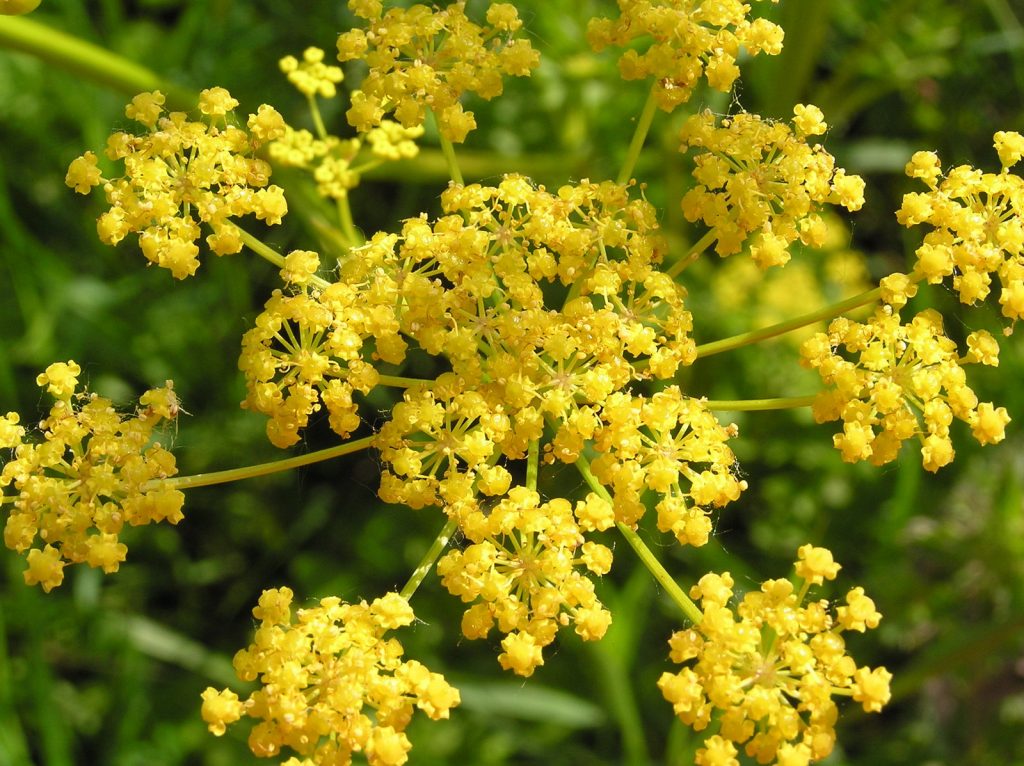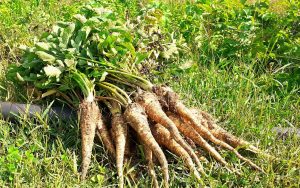
Wild Parsnip makes a flat-top yellow blossom.
Wild Parsnip, Pastinaca sativa, is native to Europe but is found in all of North America except Alabama, Mississippi, Georgia and Florida. It’s a root vegetable closely related to carrots and parsley and has been cultivated since at least the early Greeks. It was part of the tribute the Germans gave to Roman Emperor Tiberius. Both English immigrants to America and French to Canada brought the plant with them.

Be sure of your identification.
If we combine two reports we can get a good accounting of Wild Parsnip’s nutrient profile. A 100 gram sample has 76 calories, 1.7 grams of protein, 0.5 grams of fat (mono- and saturated) 17.5 grams of carbohydrates and two grams of fiber. Vitamin A is minor — 3 RE, but vitamin C is good: 16 mg a little over a third of your daily need. The B vitamins are B1 (thiamin) 0.08 mg, B2 (riboflavin) 0.09 mg, B3 (niacin) 0.2 mg, and B6 (pyridoxine) 0.85 mg. The minerals are potassium 541 mg, phosphorus 77 mg, calcium 50 mg, magnesium 29.4 mg, sodium 12 mg and iron 0.7 mg.
Tasty and nutritious so what’s the down side? It’s in the same family as Poisonous Hemlock so you have to make sure of the identification. Taste and aroma is not enough. By the account of victims Poisonous Hemlock root also smells and tastes like parsnip. That said Poison Hemlock produces white flowers on stalks creating a more rounded appearance like an umbrella. I tell my students a white umbrella made up of smaller umbrellas. Wild parsnip has yellow flowers on stalks producing a more flat-topped appearance. Wild Parsnip has celery-like leaves and deeply grooved main stalk that is green. Poison Hemlock has smoother stems if not splotched with purple and the leaves are more fern-like.
What Pastinaca means is foggy. It can be from “pastinum” meaning food or to prepare the ground for planting a vine. If so then “sativa” is redundant as it means “sown.” Parsnip is from Pastinum which passed into Old French as pasnaie then into Middle English as pasnepe. The current ending -nip was added by mistake because folks thought it was related to turnips which it is not.
Green Deane’s Itemized Plant Profile
IDENTIFICATION: A two-year plant, basal rosette of roughly hairy leaves, strongly aromatic when crushed. Leaves compound, pinnated, broad, with toothed edges, leaf stems grooved, main stalk grooved, second-year stalk taller than first year. Blossoms yellow making a flat-top arrangement.
TIME OF YEAR: This is a plant you have to identify this year and the harvest next year. The first year it is a basal rosette growing a tasty root. The second year it sends up a flower stalk. Flowering starts in May and can last to July or even October depending on climate and location. You can also harvest roots at the very beginning of year two. But once the plant is flowering the roots grow woody.
ENVIRONMENT: It is rudual meaning it likes disturbed ground from abandoned fields to roadsides. It prefer a little dryer soil to a little wetter but it can some moisture.
METHOD OF PREPARATION: Be sure of your identification. Check with a local expert. Roots raw, boiled, steamed, sauteed, mashed, pureed, baked used in soups, stews, sauces. Also made into beer and wine. Young leaves coked. Seeds used for a dill-like seasoning. Wear gloves and a long-sleeve shirt when harvesting just as you would cultivated parsnips. Sap on sweaty skin which is then exposed to sun can cause a rash that can last for months.


You should also mention that wild parsnip is dangerous to harvest due to high levels of furanocoumarin in the stems. When the sap from broken stems gets on our skin and is exposed to sunlight, the furanocoumarin in the sap gives you a VERY nasty chemical burn. Only the root should be eaten. Not leaves or seeds.